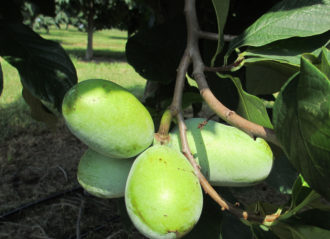FRANKFORT, Kentucky – Kentucky State University researchers, through a grafting technique common in apple production, have been successful in producing higher-yielding, higher-quality fruit in pawpaws. The results help promote a low-input system to boost small-scale pawpaw production for small farmers.
Through a $203,395 Southern Sustainable Agriculture Research & Education Grant, horticulturist Kirk Pomper and his colleagues used bark inlay grafting on three commercial pawpaw cultivars: ‘KSU-Atwood’, ‘Sunflower’, and ‘Susquehanna’. Grafting secures the top of a plant (the scion) to the lower rootstock for the purpose of strengthening cultivars, improving production, increasing yields, and building insect and disease resistance, among other benefits by joining the desired traits. With bark inlay, a thin layer of bark from the rootstock is removed, two parallel inlay cuts are made through the bark, and the scion is inserted into the inlay cuts and secured.
A Kentucky State University video explains the technique of bark inlay grafting in pawpaw production.
Pomper said that bark inlay is common in fruit trees, particularly in apple orchards, because of the superior strength of the union. “The technique, however, has not been well developed for pawpaw,” said Pomper. “The method was studied as an alternative to the negative effects of spring heating of grafts, as well as improve timing for successful spring grafting and cultivar selection.”
In the project (LS14-265), “Jump Starting Pawpaw Variety Production for the Industry: Developing grafting and top working approaches for growers,” the researchers grafted three trees of each cultivar using the bark inlay method in May (the ideal timeframe for grafting pawpaws) over a three-year period. The grafts took place in early May and in late May; scion take, flowering, and fruiting response times between to two grafting dates were measured.
Results found that the pawpaw cultivars had a higher success rate, greater growth and more precocious flowering and fruit production when the bark inlay grafting was performed in early May as opposed to late May.
Over the three-year study (2016-2018), trees grafted in early May had an average survival rate of 78 percent compared to an average survival rate of 48 percent of those trees grafted in late May. Trees grafted in early May grew an average of .69 m compared to an average growth rate of .56 m for those trees grafted in late May.
“More robust flowering and fruit production two years after bark inlay grafting was seen in trees grafted in early May,” said Pomper. Trees grafted in early May 2016, for example, produced more flower buds per tree and only trees grafted in early May produced fruit in 2018, producing an average of 12 fruit per tree. Grafted pawpaw trees generally flower and fruit 3-4 years after grafting.”
Kentucky State University is developing bulletins and other educational resources on the bark inlay grafting technique and has held several field days demonstrating the process. Researchers hope that the results of the project will help increase pawpaw yields and enhance high quality marketable fruit from grower plantings.
Published by the Southern Region of the Sustainable Agriculture Research and Education (SARE) program. Funded by the USDA National Institute of Food and Agriculture (NIFA), Southern SARE operates under cooperative agreements with the University of Georgia, Fort Valley State University, and the Kerr Center for Sustainable Agriculture to offer competitive grants to advance sustainable agriculture in America's Southern region. This material is based upon work that is supported by the National Institute of Food and Agriculture, U.S. Department of Agriculture, through Southern Sustainable Agriculture Research and Education, under sub-award number: LS14-265. USDA is an equal opportunity employer and service provider. Any opinions, findings, conclusions, or recommendations expressed in this publication are those of the author(s) and do not necessarily reflect the view of the U.S. Department of Agriculture.
